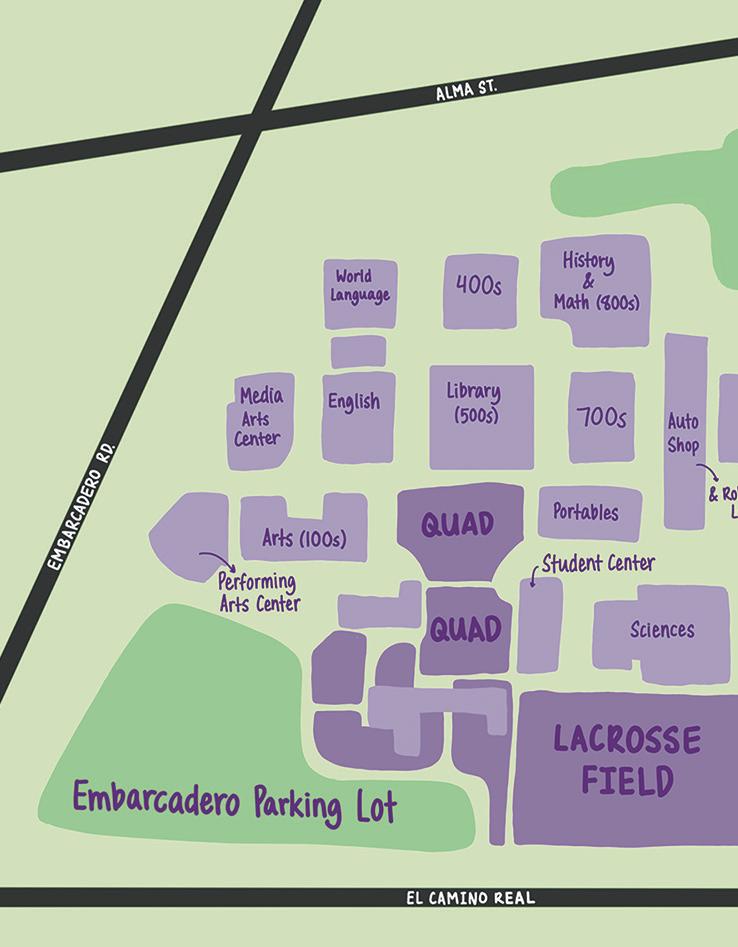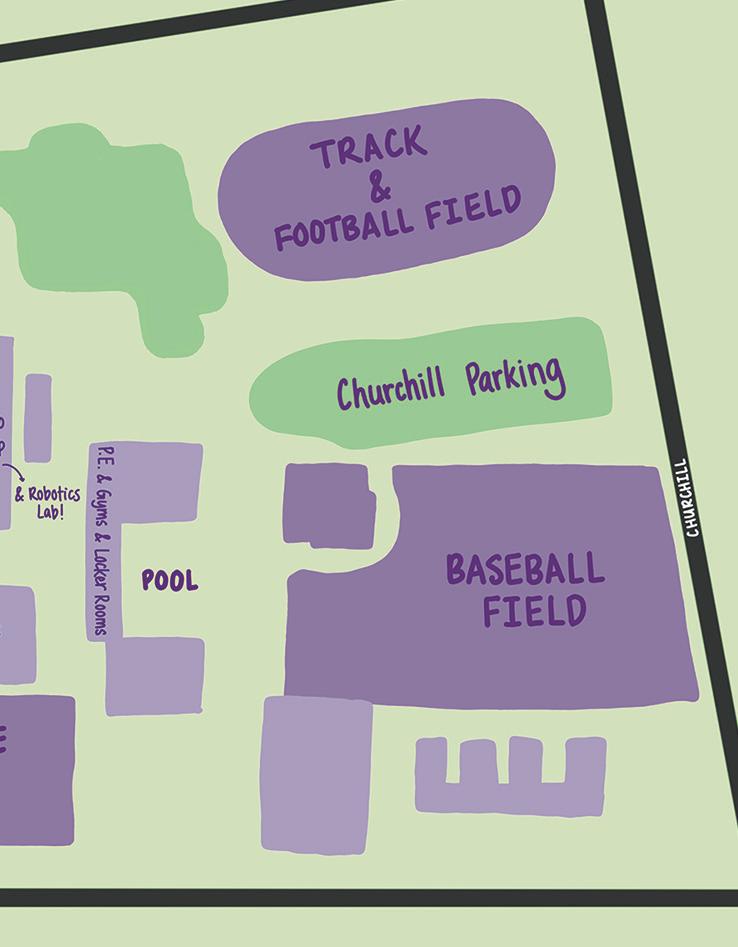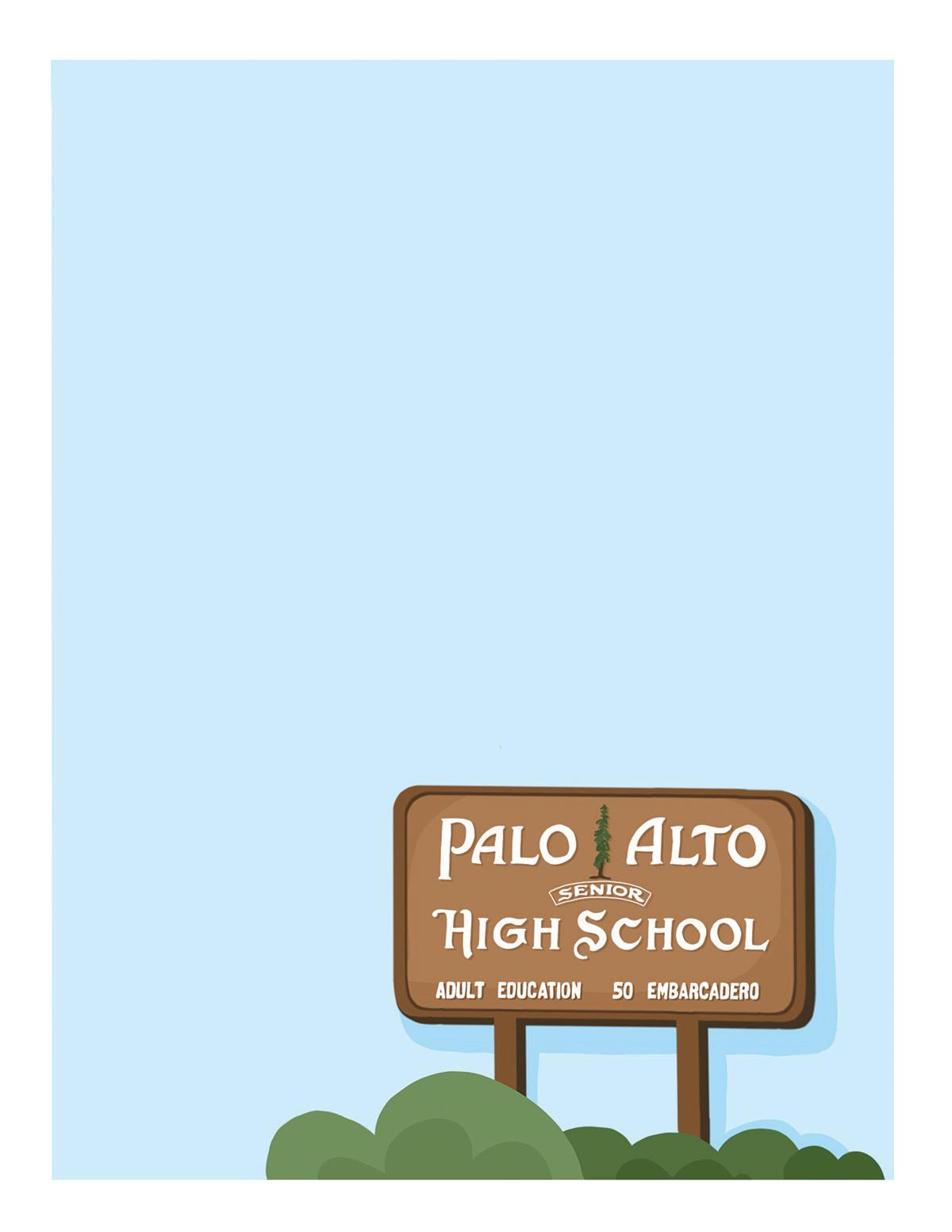Palo Alto High School Guidebook

A guide to navigating Paly as a historically underrepresented student


A guide to navigating Paly as a historically underrepresented student
Hi everyone!
Welcome to the second edition of the Palo Alto Guidebook — this time, made specifically for first-generation students. This guidebook is intended to help you navigate high school as the first student in your family to go to college; our goal is to mitigate the challenges you may encounter throughout your transition. This book is packed with genuine advice, pointers to helpful resources and more to help you with your academic journey.
One of the most useful resources for Paly students is the College & Career Center. On page 4, you’ll find a spotlight on this fantastic support system and how it works. Page 5 kicks off the core of this guidebook: advice from first-generation students in

the Class of 2025. They were all in your shoes four years ago and have since then completed the college application process, and we are so excited for you to read what they have to tell you!
Later on, page 9 shares advice from teachers who work closely with first-generation students, either in their classes or through the AVID program. Your teachers will become a huge part of your high school experience, so be sure to check out what they want you to know!
As you flip through this guidebook, the latter half will help you gain a deeper understanding of what Paly has to offer. Pages 12 and 13 will give you a taste of the courses that you can take throughout your time here, including unique electives and Advanced Placement courses.

Another gem at Paly is the Tower Learning Center, where you can sign up to find a peer tutor for any subject you need help with. On page 14, you’ll learn more about this fantastic resource and how it can help students during all four years of high school. Finally, page 15 dives deeper into the Media Arts Center — a hub for creativity, teamwork and fun. The two-story building is rich with opportunities to participate in journalism, art, music and more. We hope this guide will ease the transition from middle to high school and provide readers with helpful advice from people who have been in your shoes before. We cannot wait to see what you do in your time at Paly!
Happy reading!


We would like to thank the MAC Boosters for selecting us to be a part of their 2025 Spark Grant projects and funding this project. Additionally, we would like to thank our adviser Brian Wilson, MAC Boosters member Diego Rodriguez and all the teachers who make the AVID program come to life. And, thank you to Emily Tang for brainstorming initial ideas with us. We could not make this guidebook happen without your support!
The First-generation Student Guidebook is an advice-based guide to navigating high school as a first-generation student. Every story is written and designed by Paly students, featuring voices from teachers and students across the school. This guidebook is distributed directly to first-generation students in the Class of 2029 at no cost to the student body.
Uriel Almanza, Nathalia Arias, Swain Brooks, Caitlin Drewes, Lucy Filppu, Scarlett Frick, Alexander Gutierrez Nava, Diego Gutierrez, Angelah Hernandez, Samuel Howles-Banerji, Justin Kim, Ellie Knott, Crystal Laguna, YJ Lee, Brianna Meza, Cynthia Molina, Aaron Nance, Aparna Sankararaman, Ana Steir, Keith Tocci, Teresa Wang
Table of Contents
Talia Boneh
Adviser
Brian Wilson
Editors-in-Chief
Talia Boneh
Ria Mirchandani
Amalia Tormala
Sophia Zhang
Cover
Talia Boneh
Sophia Zhang
The C&CC is a valuable resource for all students, regardless of grade level
Text and design by AMALIA TORMALA
WWhen most people think of a library, they imagine a space with towering shelves stuffed with all kinds of books. They, most likely, do not imagine an office dedicated to providing Paly students with key insight into their futures — the exact function of Paly’s College & Career Center.
The College & Career Center serves as a resource for Paly students to plan their post-high school lives. From 8:30 a.m. to 4 p.m., its doors are wide open for both drop-in appointments and scheduled, in-depth conversations between students and designated faculty.
The C&CC’s team is composed of four members, including college pathways counselor Crystal Laguna, who works primarily with first-generation students; college advisor Janet Cochrane; college advisor Sandra Cernobori; and receptionist Jen Fernandez. Laguna’s word of choice to describe her colleagues? Dedicated, she said.
meeting one-on-one with students, the C&CC’s Schoology page has multiple, valuable resources for students, Laguna said. For one, awards and scholarships for students to apply to are regularly posted on the page, which provides all students with an opportunity to entertain the possibility of a collegiate education. Additionally, the Schoology page has several folders in which students can discern key information regarding standardized tests, college applications and any other information they may need.
Laguna also hosts regular workshops during PRIME or study hall — in addition to a parent night — catered specifically toward first-generation college students.
“There is something here for everyone, and we’d like to think of it as a hub for all things after high school.”
“It [the C&CC] is a resource for all students because of the fact that there are staff here who are available and willing to help support any student with any post-high school option, whether they want to go [into] a trade, go to community college, go to a four-year [college] or take a gap year,” Laguna said. “There is something here for everyone, and we’d like to think of it as a hub for all things after high school.”
— Crystal Laguna, C & CC Counselor
Aaron Nance, one such student, said he found the C&CC incredibly valuable in his journey toward preparing for college.
“The hardest part about preparing to go to college as a first-generation student was finding the steps to take in the college application process and where to start,” Nance said. “Luckily, that’s why we have a lot of these resources at school, like the College & Career Center. I went there a lot towards the start of the application process to ask questions, and they were extremely helpful.”
Following a mandatory second semester presentation from the C&CC during juniors’ social science classes, they are eligible to make appointments to meet with individual college advisors — Cernobori handles last names A through K, while Cochrane’s group is the set of last names L through Z. All first-generation students can see Laguna.
In addition to hosting in-person events and
If there is one key takeaway Laguna hopes students gather, she said it is that students dropping by to check in with Laguna or engage with the C&CC’s resources “is never too much.”
“We [the C&CC] would love to see students come in and ask questions,” Laguna said. “By all means, if students want to come in on a weekly basis just to ask questions, we are more than happy to provide that support. Just visit us and find out what we’re about.”
High school is a whirlwind of exciting classes and new memories. As a first-generation student, it is natural to feel uncertain about aspects of high school, like what classes to take and building connections with teachers. However, many students have successfully gone through the same path you are now beginning. Here, first-generation graduates of the Class of 2025 who were a part of the Advancement Via Individual Determination Program, an academic support program that supports college and career preparation, share their advice.
For many first-generation students, the path to college may seem complicated. In order to mitigate feelings of uncertainty throughout the process, Brianna Meza, a Paly Class of 2025 graduate and former AVID student, urges students to recognize their friends’ influence.
“Surround yourself with people you know are going to push you and not going to bring you down with them, or with people who know their future and have
their stuff planned out,” Meza said. “You are who you hang out with.”
On the other hand, it may also be helpful for some students to find a balance between a busy social life and finding time to decompress alone. Angelah Hernandez has always believed that spending time in solitude is just as important.
“Don’t be scared to be alone,” Hernandez said. “You could learn more about yourself.”

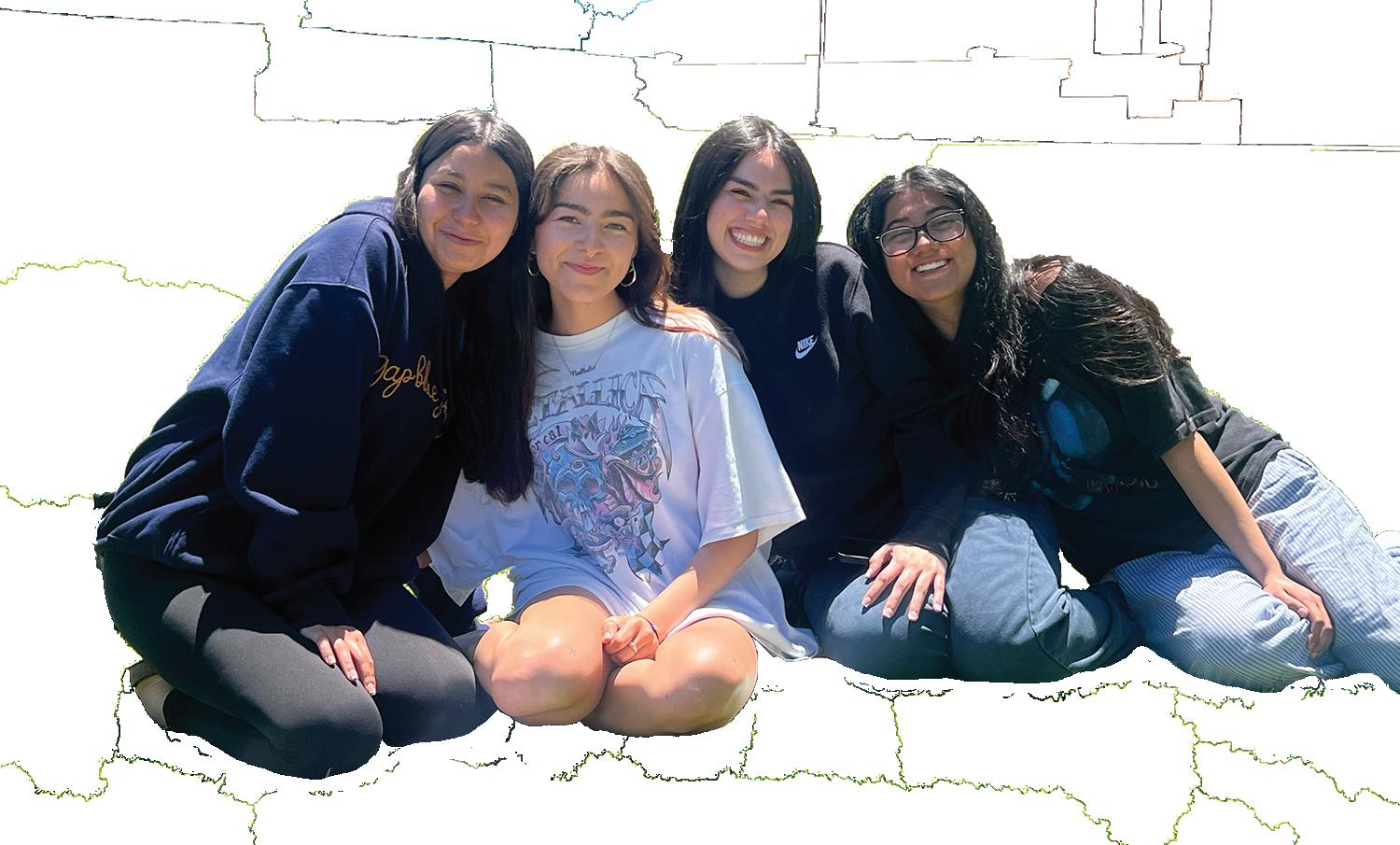
Inevitably, teachers play a big role in one’s high school experience. Paly’s school counselors also offer extra support when students are choosing classes, transitioning from each year of high school to the next and try ing to get the most out of Paly’s resources.
For Hernandez, the sup port that her guidance counselor offered her was especially helpful given that students are assigned the same counselor for all four years.
found that connecting with her teachers encourages her to ask questions.
“I’ve been that student that was uncomfortable raising their hand in a classroom,” Hernandez said. “It’s scary at first, but if you build a relationship with the teacher, it’s not going to be as scary because you know them.”
In four years, you’re going to leave and look back and [want to] be glad that you did what you needed to do in order to be successful.
“Have a relationship with your counselor,” Hernandez said. “They are the ones that know you the most, since they’re going to be with you for all your four years.”
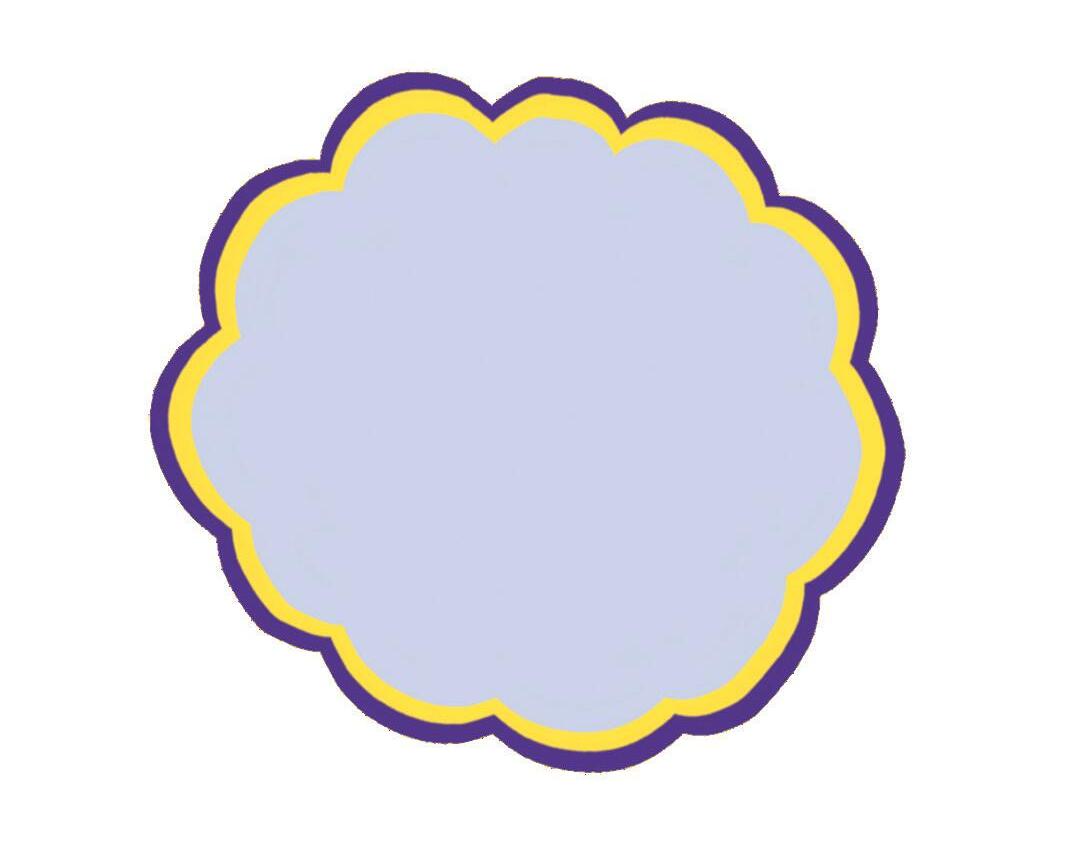
—UrielAlmanza,‘25
Throughout her years at Paly, Molina main tained a strong connection with Crystal Laguna, Paly’s current guidance counselor for first-generation students, and said she regularly reached out for support during the year.
“Miss Laguna was super helpful … because she’s been in our shoes [as a first generation student] before,” Molina said. “Having that understanding and knowing that you aren’t alone in the way you feel definitely helps.”
During class, teachers can be a helpful resource for students to ask for help and questions. Although it may be uncomfortable to speak up for oneself, Hernandez
Similarly, Diego Gutierrez always felt welcome in his classes to ask questions.
“If students do have questions about something they don’t really understand and don’t want to ask a teacher, they will ask a friend or somebody in that class,” Gutierrez said. “If they also don’t know, it’s best to just go to the teacher. They’re never going to say no to your questions.”
For Alexander Gutierrez Nava, Paly classrooms have always offered a helpful,
“Teachers at Palo Alto High School really want to help you pass,” Nava said. “They give you the resources and everything.”
While building relationships with teachers can feel intimidating, Uriel Almanza said students should push themselves to get the most out of their classes and the people around them who are there to offer support.
“At the end of the day, you’re going to graduate and leave school, so just make sure that you take what you need, “ Almanza said. “In four years, you’re going to leave and look back and [want to] be glad that you did what you needed to do in order to be successful.”
High school is also a period of time rich with opportunities to try new activities and find what feels appealing and exciting. By actively looking for new things to learn or challenging oneself by entering unfamiliar environments, one can often discover a deep passion that would otherwise nev er have been recognized.
When Nathalia Arias joined the Paly jour nalism program, she immediately felt like she found a new, welcoming commu nity to be part of.
“Try new things,” Arias said. “That's how I found a lot of things that I would have not [oth erwise] tried, like journal ism, because I knew a lot of my friends at the time weren't doing it, and I feel like it just really helped me find my passion.”
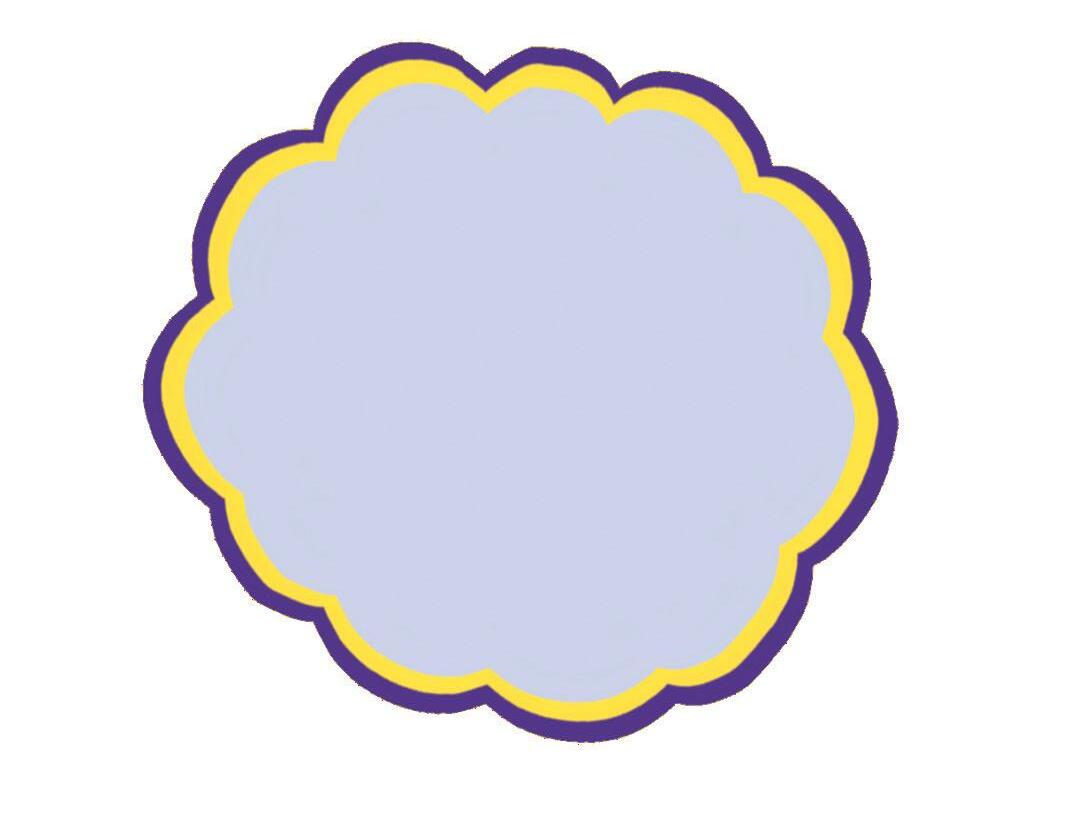
motivated going into junior year, where a lot of people are swamped because of hard classes,” Nance said. “But for me, I felt like I was becoming a new person because I found the things during my sophomore year that were an issue in my life, and I took steps to eliminate those issues to become a better person.”
“I really took a step in the right direction to becoming better when I found a support network ... by joining outof-school activities and clubs”
—AaronNance,‘25
Similarly, Aaron Nance built long-lasting support networks by branching out to find non-school related activities with people who shared similar interests to him, such as clubs.
“I had a lot of issues with other commitments in sophomore year, and I really took a step in the right direction to becoming better when I found a support network,” Nance said. “I did that by joining out-of-school ac tivities and clubs where I just connected with people who had the same interests and who were having the same issues. I felt like I wasn't alone in my issues.”
As Nance continued through high school, these new communities ended up helping him maintain a positive attitude during stressful periods of time.
“That really helped me to feel
Along with this, Paly is especially unique in its wide array of courses and resources offered to students (see page 12 for more information).
For Molina, taking the time to learn about Paly’s course offerings can be deeply beneficial for getting the most out
“Take advantage of the resources Paly offers, especially the classes,” Molina said. “I didn't know there was a glass blowing class
There is no “cookie-cutter” definition of what one’s passion will look like — for Nava, the most important aspect is having an open mindset.
said. “You just have to find hobbies, do more stuff outside of school [and] try new things.




When entering Paly, the countless cours es available provide abundant oppor tunities for students to determine what topics resonate with them the most. Arias said it is key for students to venture into classes that may feel unfamiliar.
“Sometimes, in class, I was the only minority student, and it’s hard to share an opinion that’s not shared among other people,” Arias said. “But it’s important to know that you earned your place there, and you deserve to share your experi ences with others to make sure they understand all perspectives.”
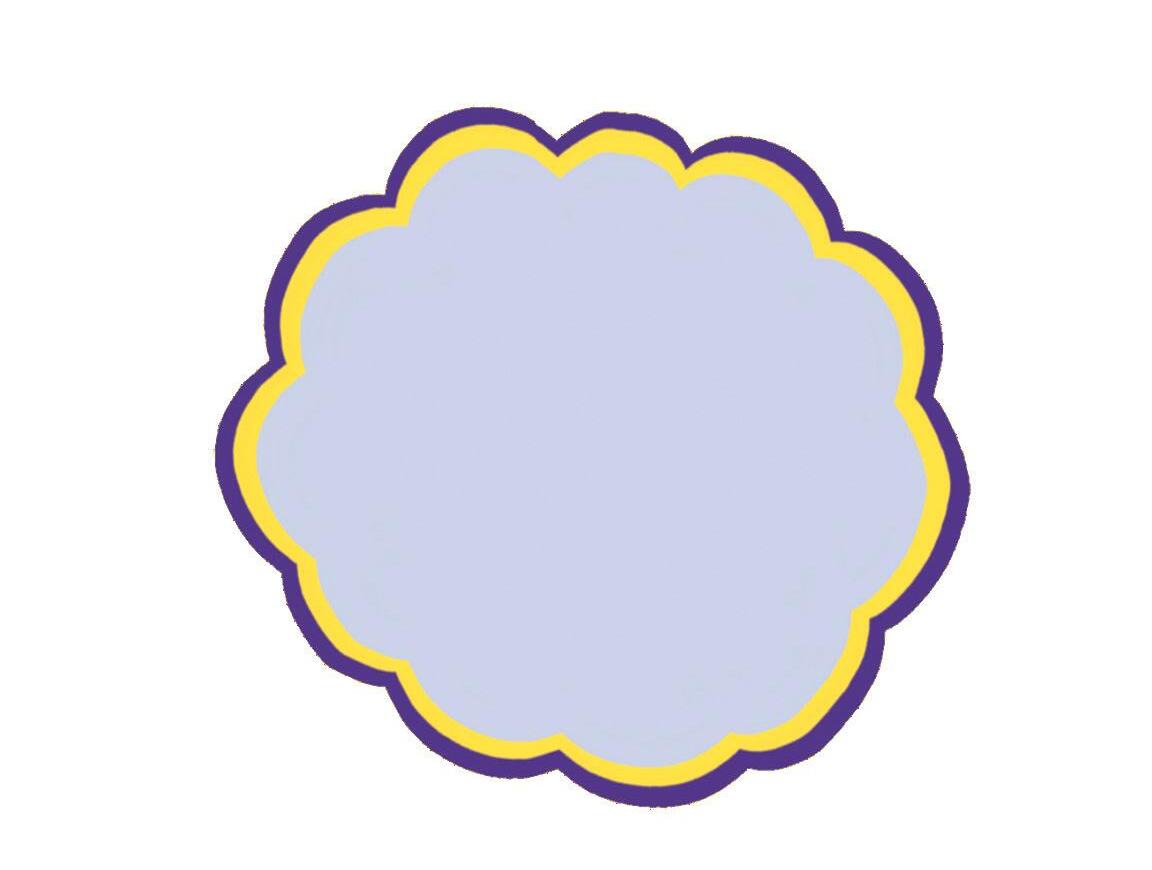
responsible for your grade, and the feeling of discomfort is going to go away once the class is
“You earned your place there, and you deserve to share your experiences with others to make sure they understand all perspectives.”
— NathaliaArias,‘25
Pushing oneself to take classes with more aggressive course rigor in moderation is another way to stimulate academic growth. In his junior year, Nava realized the benefits of taking challenging courses that suited
Molina experienced similar feelings of discouragement as the only Hispanic student in her AP Psychology class. In Molina’s case, she said she found that the best approach to reduce these feelings is to simply focus on oneself.
“I felt discouraged at the beginning, especially since it was such a hard class and I didn’t really know anyone,” Molina said. “One piece of advice to help with this is just don’t care. At the end of the day, you’re the one that’s taking the class and
you in the mindset to try in your classes. If you take only easy classes, you slack off way more.”

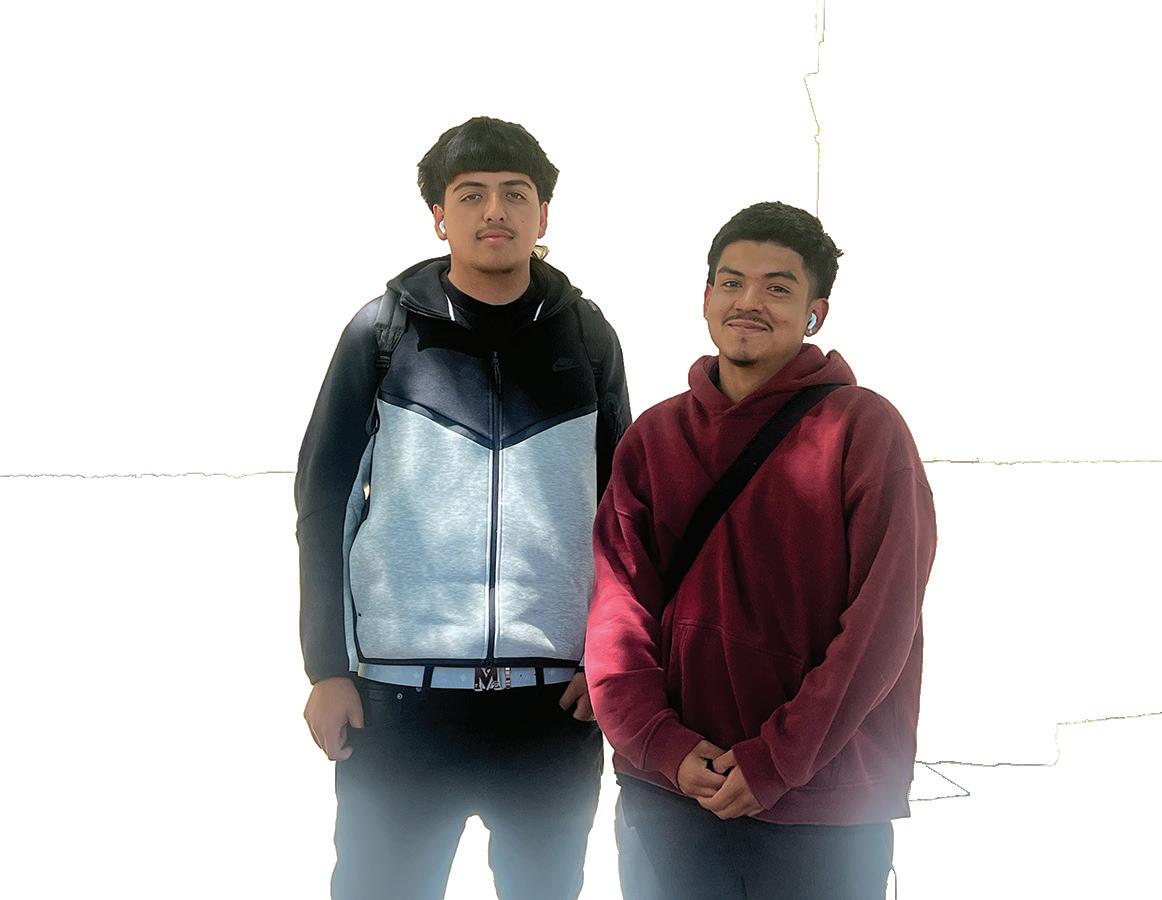
Underneath the surface of being a first-gen student
Many first-generation students may feel a stronger sense of responsibility to succeed in high school. For Meza, it is essential for one to maintain a strong work ethic and set a positive precedent for the generations to come.
“You’re setting a standard for your family,” Meza said. “You’re going to represent your family. You’re going to represent who you are going into the school, and if you come in not caring
that just shows who you are as a person.”
Looking back at his hard work throughout his high school years, Nance said he is proud of exploring all the opportunities around him.
“I’m taking a step for possible future generations to be a role model, taking initiative and trying something that people in my family haven’t tried before,” Nance said. “It just feels great being able to feel like I’m doing something new.”
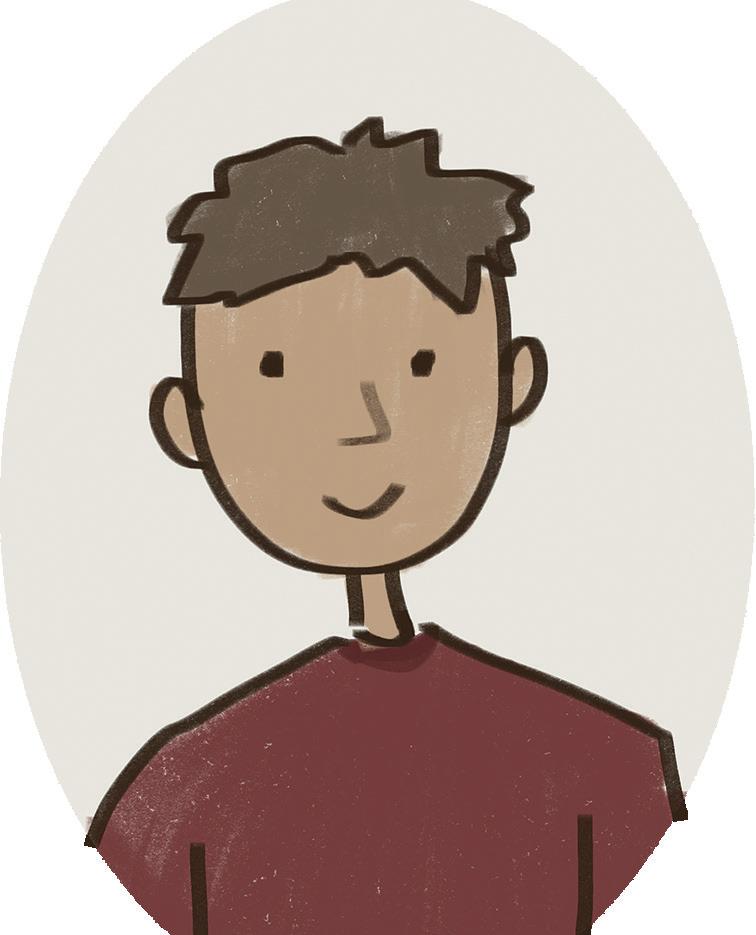


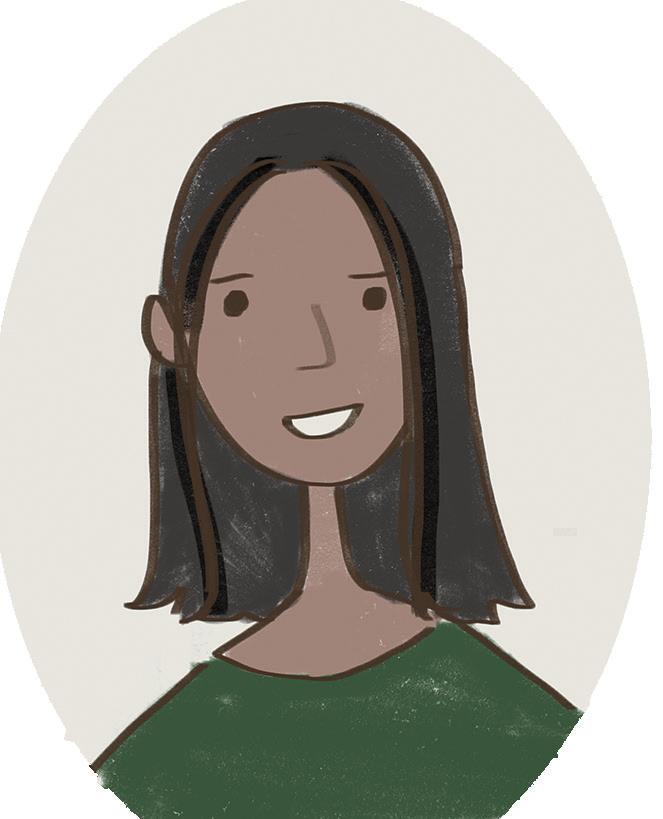
Read about the insight that teachers have into juggling academic and everyday life
“Be in communication with your teachers with what is going on,” Tocci said. “It feels obvious, but it can sometimes be scary.”
“Most teachers will be receptive to whatever it is you’re going through, whether that could be some kind of challenge or if you are really appreciating something,” Tocci said.
“The more teachers have a sense of who you are, the easier it becomes for them [to help you],” Tocci said.

“There are a lot of opportunities on campus,” Drewes said. “[Social Justice Pathway] is one of them. AVID is another. The band program is amazing. The track team is [also] a great inclusive community, and journalism is big and broad.”

“With APs, with college, [or] with any opportunity, you have to be a little bit brave to succeed,” Drewes said. “Just because you don’t know anybody who’s ever done it should not stop you.”

“High school is a safe environment for you to try and fail,” Sankararaman said. “It’s harder to do that once you have a job. So don’t let the failures in high school bring you down. Use them instead as a lesson.”
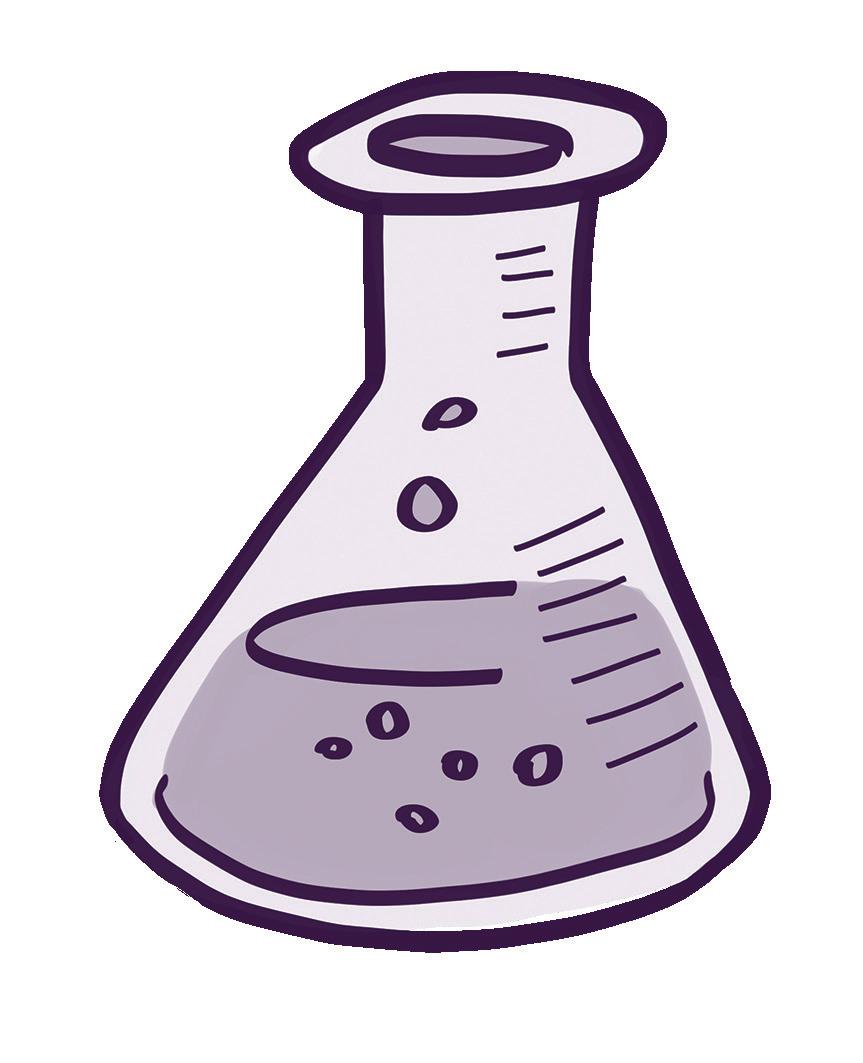
“Don’t underestimate the library as a space where you can go study [and] collaborate,” Sankararaman said. “Being surrounded by books and other students who are studying makes it feel like you need to put [your] phone away and study as well.”
“If you are not immediately comfortable talking to your teachers, try [talking to] your classmates, because there’s a good chance whatever you are struggling with others may also be struggling with that,” Sankararaman said.
Read more about specific programs (Social Justice Pathway, Peer Mentorship) on the next few pages...
An overview of two opportunities on campus. Explore paly. net/learning/programs-pathways for a full list of programs
Arms are thrown over each other, laughter is shared and yearbooks are signed. Despite only meeting nine months ago, mentors and mentees now struggle to say goodbye.
Started in 2023, the Peer Mentorship Program pairs juniors in the AP Seminar classes with seniors in AP Research. AP Seminar teacher and facilitator of the mentorship program Lucy Filppu believes this program builds crucial bonds between students.
struggle, regardless of how fascinating the topic is.
Filppu encourages students to push themselves in the classroom setting, promoting the idea that the most rewarding part of the class comes after working hard.
“Be open to rewriting the narrative of who you are as a student”
Lucy Filppu, AP Seminar Teacher
“We disrupt friend bias, which is another word for cliques,” Filppu said. “This [may be] helpful for AVID students, who might be spending a lot of time with kids from their neighborhoods.”
Additionally, Filppu thinks that AP Seminar is an option for students as one of their first AP courses given that it is a portfolio-based class, meaning that a large part of the gradebook is determined by written papers as opposed to tests.
Teachers understand that classwork, especially for a challenging class like an AP or honors course, is not always leisurely. The writing process for a research paper can often be a
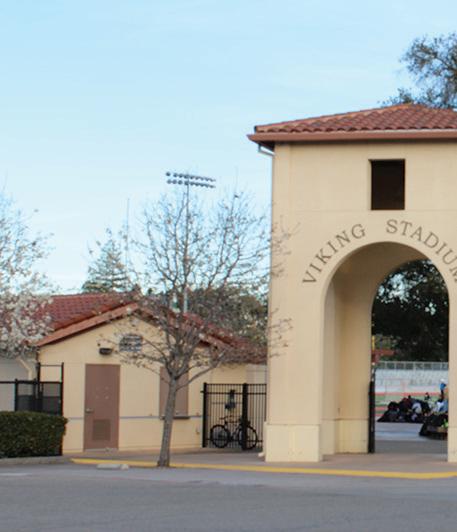
“There isn’t a person on the planet who hasn’t had to get through something to get to the other side,” Filppu said. “There’s something to be said for stamina and staying engaged.”
The program continues for two years, which gives students a chance to hone and focus on their skills.
According to science and AP Research teacher Samuel Howles-Banerji, the skills that the AP Capstone program helps build are vital in higher education.
work in high school but are expected in colleges,” Howles-Banerji said.
For students part of the AVID program, Howles-Banerji suggests that they talk to these teachers about their interests, even if they may be non-academic.
“Your teachers are people, and in most cases, they actually enjoy engaging with students,” Howles-Banerji said. “We’ve had a lot of conversations about music [or] about work. Having those conversations and building that rapport is important.”
“Your teachers... actually enjoy engaging with students”
“One of the things that we’re focusing on in Capstone are skills that are not necessarily directly taught as part of a class,” Howles-Banerji said.
Programs like AP Capstone are a space where students can redefine their experience. These classes are the product of months of investigation and research, which differ from a traditional essay or test, allowing students to demonstrate their intelligence in a unique format.
Samuel Howles-Banerji, AP Research Teacher
AP Capstone is also a helpful preparation for college.
“These are skills that aren’t necessarily part of most course-
“Be open to rewriting the narrative of who you are as a student,” Filppu said. “Prepare to become confident, prepare to kick butt. Prepare to be that nerdy, high-achieving kid on campus that you didn’t think you could become.”
Whether they are preparing for their Junk Couture fashion show, annual camping trip or writing an essay about philosophy, it is apparent that students part of the Social Justice Pathway — or SJP — are given a space to discover themselves.
This is exemplified inside and outside of the classroom, according to English teacher and SJP advisor Keith Tocci.
“The goal of [the Social Justice Pathway] is apply learning it to a context beyond the classroom and to build community through doing that,” Tocci said.
Campus can sometimes feel isolating, especially when each class has a different group of people. SJP provides an alternate learning model: a three-year program with familiar classmates.
“You have a whole community of people that you’re growing with,” Tocci said. “You also have two teachers who are there for you across multiple years of the program.”
Another aspect of being in SJP is the flexibility of the coursework that other classes may not provide. As a result of the meaningful relationships built throughout the program, assignments are more flexible and accommodating of each individual student.
“There are many more opportunities to showcase your skills and push yourself in the classroom,” Tocci said. “For Tocci, the main benefit of SJP is the network. Due to the amount of time that teachers and peers get to
know one another, they are able to empathize with any struggles that might arise.
“If you’re going through something or facing a challenge, there are other people who are there to support you,” Tocci said.
At its core, SJP is designed to be a space where students can explore issues related to social justice, particularly thinking about the many intersections of history and English.
SJP advisor and history teacher Caitlin Drewes believes that students who are part of the Tinsley program, which brings students from Ravenswood City school district in East Palo Alto to Paly, often feel strongly about social justice.
of the Tinsley kids stick with Tinsley kids, lacrosse boys stick with lacrosse boys,” Drewes said. “With SJP [and] because they are together for so long, they are forced to break this down and a lot of unexpected friendships form that way.”
“You have a whole community of people that you are growing with”
Keith Tocci, English Teacher & SJP Advisor
Despite its many benefits, SJP is not the right fit for every student. Those who gravitate toward individual work or prefer lecture-based learning can still participate in one of many other programs on campus.
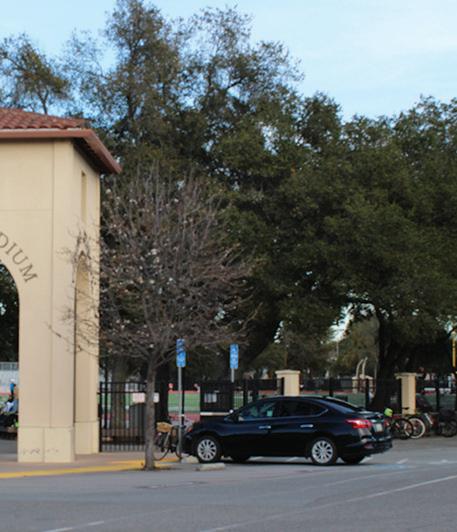
“Because a lot of them have grown up with and been personally affected by [social injustice], a lot of Tinsley students are deep, passionate activists around social justice,” Drewes said. “Which is fantastic, but I think having teachers who know what they’re potentially capable of and helping them reach those goals [is important].”
Drewes also speaks to the fact that SJP is a disruptor in social circles that tend to form on campus — it serves as an opportunity to create bonds that would not have been formed otherwise.
“Paly is a high school, so a lot
“There are a lot of opportunities for community and for connection, but you do have to make an effort and put yourself out there a little,” Drewes said. “The first one might not fit. You might try SJP and say, ‘Nope, not for me’ and find that the Campanile [Paly’s student newspaper] is the place you want to be, or maybe you have a foot in each which is great.”
While all the different optios may seem intimidating initially, Drewes encourages students who may hesitate from seizing academic opportunities to try something new and picture themselves achieving something outside of their comfort zone.
“If you aren’t used to grabbing the opportunities, sometimes you just have to visualize yourself in them and trying them will [pay off],” Drewes said.
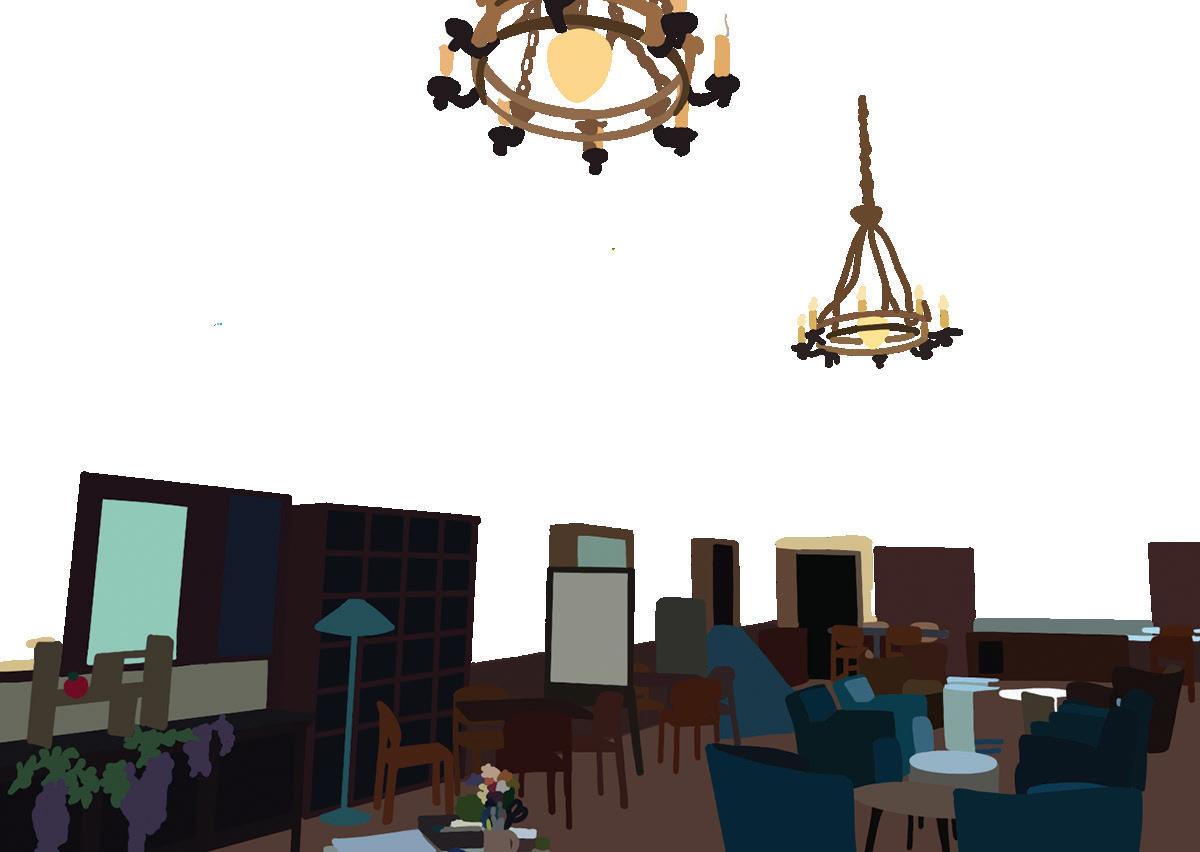
Inside a newly renovated campus hub, students find academic support, mentorship and motivation through personalized tutoring
Within an expansive space filled with cozy chairs, tables, floor-to-ceiling windows, candlestick chandeliers and warm ambience, the chatter of student conversations and calming music permeates the air. During the busy school year, the Tower Learning Center welcomes students, offering free tutoring with peers and adults in a variety of subjects. The center is open Monday through Thursday from 8:00 a.m. to 5:30 p.m. and is located within the newly-renovated Tower Building. Before the tutoring space opened last year, Tower Learning Center coordinator YJ Lee established its goal: to empower students to take charge of their own learning.
“One
tutors to be able to guide, mentor, look at the assignments and be like, ‘Hey, you have a test coming up next week. How do you want to break apart our session or your study time, or create a schedule together for accountability?’”
of the best things about learning is just when you realize that you can do so much for yourself.”
— YJ Lee Tower Learning Center coordinator
“One of the best things about learning is just when you realize that you can do so much for yourself,” Lee said. “Sometimes you need help with that, and that’s why we really want our
The process of becoming a tutor involves navigating to the Tower Learning Center website (paly. tutorconnect.app) and applying through a form detailing one’s availability on specific subjects. This is followed by an interview with immediate feedback to equip students with the necessary skills to succeed as a tutor. A similar process is in place for scholars seeking tutoring support, without the interview.
“We match [tutors and scholars] based on the tutors’ responses and scholars’ preference,” Lee said. “Everyone has their different strengths, and everyone has their different
preferences. And so with whoever is here, if we figure out what a scholar needs and what they would prefer, we match them with the tutor who can meet their needs.”
By tailoring support to scholars’ learning styles, the TLC supplements what students like sophomore Ana Stier learn in class.
“TLC tutoring complements class because it’s easy to bring your notes and classwork and get help right away,” Stier said. “Since the student tutors have taken the same course, they give strong advice and tips that really make a difference.”
with her tutor.
“My tutor is not just a tutor but also a friend who is genuinely so kind and sweet,” Knott said. “She reminded me that there are people there willing to help me succeed.”
“Being in the TLC has changed how I approach learning because my tutor has helped me develop a more open mindset toward subjects I find difficult or dislike.”
— Ana Stier, ‘27
Lee hopes scholars will apply the strategies and advice from tutoring sessions beyond the class room by solidifying a long-term excited mindset.
“The hope is that the scholar doesn’t depend on the tutor,” Lee said. “We don’t want the scholar to go home and be like, ‘Oh no, I don’t have my tutor. I can’t do this anymore, so I’m just going to wait until my session.’ We hope that they would think, ‘Okay, what did my tutor teach me, and how can I apply that for myself?’”
Alongside helping students familiarize with ap proaching problems, Stier said that the Tower Learning Center has allowed her to develop posi tive working habits.
“Being in the TLC has changed how I approach learning because my tutor has helped me develop a more open mindset toward subjects I find diffi cult or dislike,” Stier said. “Without this resource, it would have been very difficult to build a steady and strong foundation for my studying and success. I would have had much lower motivation and strug gled more with staying on track.”
Scholars strengthen their problem-solving skills as well. Paly graduate and former tutor Justin Kim said that the best way to learn is by teaching some one else.
“When I tutored underclassmen for the SAT [Scholastic Aptitude Test], I was not only teaching them good habits but also reinforcing good habits for myself,” Kim said. “I found that through tutoring I excelled and learned at a faster pace, too.”
Throughout the tutoring sessions, scholars and tutors build meaningful relationships that go be yond academics. Junior and scholar Ellie Knott saw this through the supportive connection she built
To Lee, watching this dynamic unfold is the most rewarding part.
“My favorite thing is seeing all the students come in and work together,” Lee said. “I know that sounds so vague and generic, but when a student comes in and they work with another student, it’s just like seeing worlds collide. The TLC is not just a shared space: It’s an intentional shared space.”
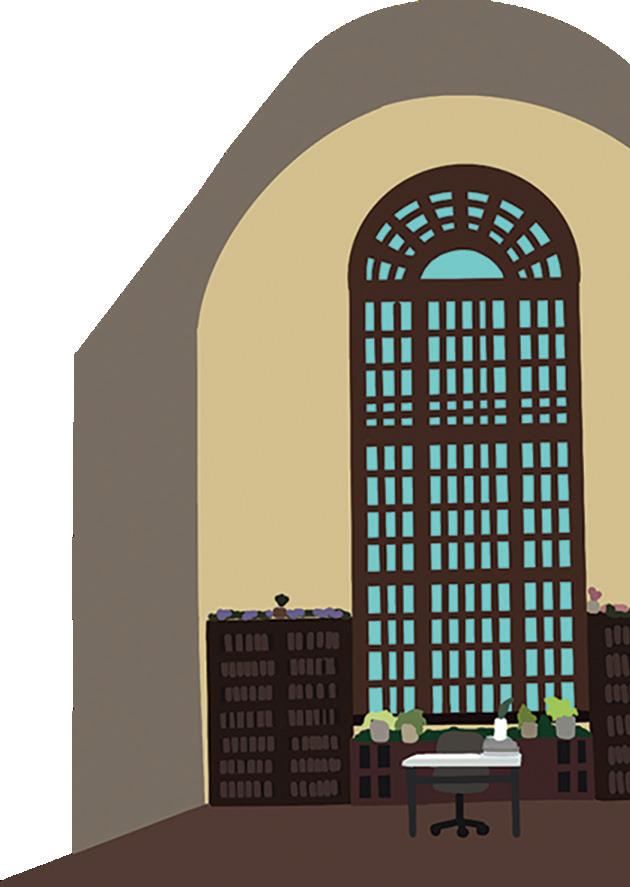
Take a peek into Paly’s renowned Media Arts Center
Every year, freshmen flock to Paly’s campus, dazzled by the immediate access to Town and Country and the newly-renovated Tower Building. As they wander, they see a two-story, angular building with a long, thin screen just above the doorway. Maybe they step inside the doors, or maybe they don’t; regardless, they have just laid their eyes upon one of Paly’s many treasures: the 10-yearold Media Arts Center, commonly referred to as the MAC.

“You’re trying to tell a story, involve more people into other people’s lives and share other people’s stories.”
Nathalia Arias, ‘25 Former AVID student
media arts: photography, journalism and music. The building itself houses the technology-focused parts of Paly’s music department, entire journalism department, photography department, early-childhood education department, a computer science classroom and several other individual rooms. The Media Arts Center provides unmatched opportunities for Paly students to explore the variety of fields encompassed by the word “art.”
uses in her daily life.
“I remember doing my first journalism assignment and being so scared to go up to people,” Arias said. “It’s just knowing that, at the end of the day, you’re trying to tell a story, involve more people into other people’s lives and share other people’s stories.”
The Media Arts Center is designed to expose Paly students to the various careers that can stem directly from the core
AVID student and Paly Class of 2025 graduate Nathalia Arias said her experience on Verde Magazine changed her life for the better, providing her with invaluable skills she now

In total, the Paly journalism department is home to 12 publications — though, thanks to the Incubator, that number fluctuates year by year. The Incubator is a program that nurtures new publications to life. At the end of the 202425 school year, the Incubator housed Anthro, the social justice magazine; Chomp, the food magazine; Via Verde, the travel magazine; Proof, the photography magazine; Ink., the literary magazine; and Veritas, the science magazine.
Outside of the Incubator, there exists C Magazine, the arts and culture magazine; Campanile, the newspaper; Madrono, the yearbook; Vi-

king, the sports magazine; Voice, the fully-digital newspaper; InFocus, the video broadcast; and the aforementioned Verde magazine.
Though the journalism program is nationally-lauded and places numerous publications into the Journalism Education Association’s annual “Best of Show” contest, the MAC is home to many other noteworthy classes, including Kenna Gallagher’s photography courses.
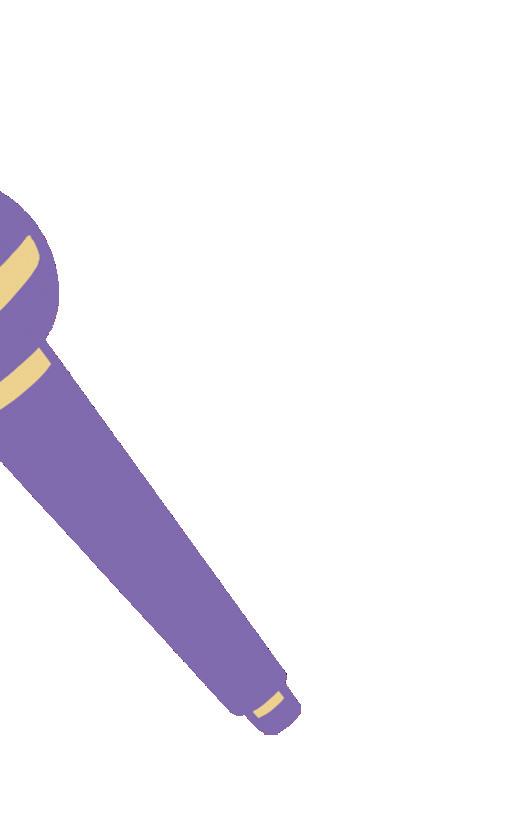

students to discover passions and new hobbies, such as learning to DJ. Teresa Wang, better known as “DJ BUTT3R,” got her start DJing in Najar’s classroom, thanks to the variety of quality resources provided by the MAC.
“The skills I have learned, technical or leadership, are invaluable.”
Scarlett Frick, ‘26
Within Gallagher’s classroom, colorful art and photographs decorate the walls. Photography students also have access to their own computer lab, which is right beside the kitchen. Paly’s budding photographers have the opportunity to take a variety of Photo classes, starting from Photo 1 and progressing all the way up to the Advanced Placement-level.
Audio and Music Production, led by Michael Najar, is a newer addition to the media arts program and Paly’s CTE class selection. Students learn the fundamentals of film scor ing, sound production and sound design.
This class is full of opportunities for

“Audio and Music Production taught me about the theory and technology behind many of the songs and sounds we encounter in real life,” Wang said. “The MAC gave me the space and assets to create and mix the music I wanted.”
In addition, the digital art and graphic design classes, all part of the Art Spectrum course trajectory, have their home in the MAC. In these courses, students learn the basics of digital design, using iPads and other drawing tablets provided by the MAC in their daily lessons.
Graphic Design picks up where Art Spectrum: Digital Emphasis ends, helping students master editorial design, magazine design, product packaging and learn the basics of digital expression.

Lastly, AP 2-D Art & De sign is taught in the MAC. This course has a focus
on photography and mixed media, making it a natural choice for students with experience in digital design.
Much of the MAC’s initial and current success is thanks to the Media Arts Center Boosters, who — from day one — made the MAC into the advanced building it is today.
The MAC Boosters are a volunteer non-profit organization, completely run by parents who partner with MAC faculty. To date, they have sponsored some of the MAC’s most wellknown projects, including the headline mishaps showcased in the bathrooms and the subscriptions to the top national journalism outlets that all students have.
All in all, beneath its shiny exterior, the MAC is a vibrant, diverse and artistic home for all students. Within the MAC, the curious and dedicated students may find the place where they thrive.
“The resources available to a person in the MAC are truly incredible,” Viking editor-in-chief Scarlett Frick said. “The skills I have learned, technical or leadership, are invaluable.”
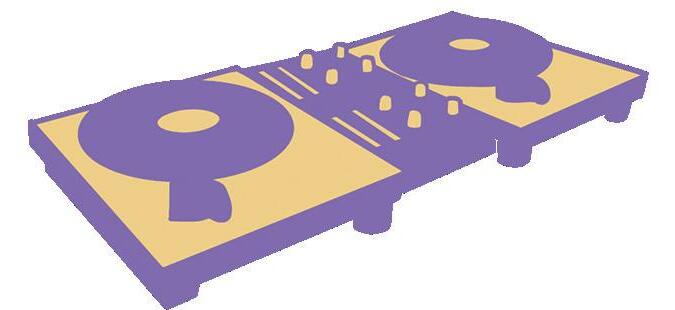
Interested in learning more? Scan here to see the MAC 10th anniversary special print issue!

